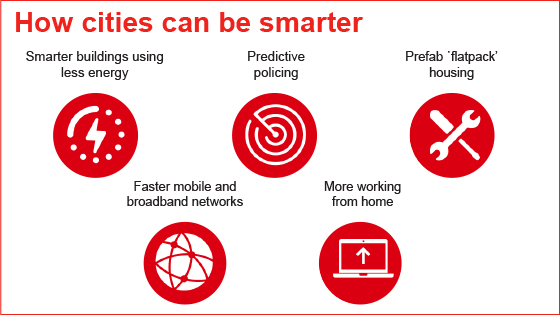By Tim Pemberton
The future of cities

Cities are the lifeblood of the global economy.
About 4.2 billion people live in cities across the world and this will rise to 5.2 billion by 2030 and 6.7 billion by 2050, according to the United Nations. Some 85 per cent of global growth could be generated in urban areas over the next decade.
But while cities bring opportunities – better jobs, education or healthcare – they can also involve issues with pollution, congestion, crime, or basic sanitation such as rubbish bin collections.
New technologies, including the internet-of-things and autonomous vehicles, can help tackle these challenges, however. We’re heading into an era of ‘smart cities’, where the connectedness of people, vehicles and infrastructure will allow cities to become cleaner, more efficient and safer places to live.
A smart city uses technology to improve the citizens’ quality of life
This is a global issue. Developed market cities need to ensure they remain attractive places to live – because demographics and remote-working may lead to peak urbanisation. In emerging countries, where millions of people will urbanise in the coming decades, many cities will be building infrastructure for the first time and have a chance to maximise the economic benefits of using smart-city technologies.
A smart city uses technology to maximise efficiency and improve the citizens’ quality of life. New construction techniques can help cities build new housing quickly, for example. Fast broadband makes it easier for more people to work from home, potentially cutting traffic and carbon emissions. Harnessing artificial intelligence could enable local governments to deliver more responsive public services.
Copenhagen, Singapore and Stockholm are smart-city trailblazers. But governments everywhere must ask how cities can cut emissions and improve air quality – and how they can reduce traffic and provide transport alternatives.
These developments can bring social as well as economic benefits. Cutting congestion can save time and enhance productivity; better housing availability attracts the best labour; and lowering pollution improves health, reducing sick days and extending working lives.
But while there are many policy options, funding is not so easy. Local governments often lack capital and think short term. Public-private partnerships are an option, but another is green bonds – debt raised to finance environmentally-friendly projects.

Governments need to think how cities can minimise the costs and maximise the benefits from mass urbanisation. One way is through technologies that utilise the spread of smartphones.
The smartphone allows better information-sharing in both directions. City-dwellers can easily check transport timetables, pay bills or find opening times for amenities, while governments can monitor transport flows and provide services more cheaply and effectively.
However, coupling this with rapidly-advancing technologies such as autonomous vehicles, the internet-of-things and artificial intelligence – made possible with the roll-out of 5G technology – makes a fully-functional smart city much more feasible through the interconnectivity of people and devices.
Smart-city technologies could allow cities to thrive economically and provide a high quality of life for their citizens.
This research was first published on 19 September 2018. Disclaimer
You must be logged in to like or comment on articles